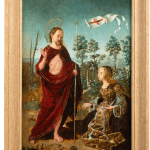Juan de Flandes (c. 1460-Palencia, 1519) (follower of)
Noli me Tangere, c. 1530
Oil on panel
40.2 x 28.7 cm (framed: 46 x 35 cm)
CHF 10'000.-
Further images
Flemish painter Juan de Flandes (c. 1460-1519) worked for Isabelle I of Castilla from 1496 until the Queen's death in 1504. After that date, bishop of Palencia, Juan Rodriguez de...
Flemish painter Juan de Flandes (c. 1460-1519) worked for Isabelle I of Castilla from 1496 until the Queen's death in 1504. After that date, bishop of Palencia, Juan Rodriguez de Fonseca (1451-1524) undertook important works in the Cathedral and decided to move the cathedral's main chapel (from what is now the tabernacle chapel to its present location, previously the retrochoir). This new and bigger space allowed the bishop to extend the main altarpiece and complete the ensemble of carvings (realized by sculptor Felipe Bigarny) and architectural decorations (realized by Pedro de Guadalupe) commissioned by the previous bishop, Diego de Deza (1443-1524). With the decision to extend the altarpiece came the idea of adding paintings: on December 9, 1509, Juan Rodriguez de Fonseca and Juan de Flandes signed a contract to make eleven paintings of the followings depictions and in the following order: Crucifixion, Road to Calvary, Burial of Christ, Resurrection, Noli me Tangere, Agony in the Garden, Christ before Pilate, Ecco Homo, Road to Emmaus, Brith of Christ, and Annunciation. Ten out of the eleven paintings are still today in the Cathedral of Palencia. The Crucifixion is now in the Museo del Prado, Madrid.
The present painting is exectued by an anonymous Spanish painter and depicts the Noli me Tangere. It is faithfully based on the painting realized by Juan de Flandes for the Cathedral of Palencia between 1509 and his death in 1519. It is therefore most certain that the painter of the present Noli me Tangere was working during the first half of the 16th century, in Palencia, where he could admire Juan de Flandes' work. Some elements have been closely copied, such as the position of Christ and Mary Magdalene, or the presence of the city in the background. Other details have been simplified, such as the sky and the decoration on the clothes of the two figures. The painter of the present Noli Me Tangere has also taken a few liberties, such as adding a few trees on the right, or modifying the colors of Mary Magdalene's drapery.
The presence, on the back, of a second painting (by another Spanish artist, c. 1550?) depicting the Crucifixion suggests that the panel was used in a workshop where two painters used the same panel. During the 19th or 20th century, the present panel was mounted in a wooden and sculpte framed that imitates the Renaissance style and with two (probably invented) coat of arms.
The present painting is exectued by an anonymous Spanish painter and depicts the Noli me Tangere. It is faithfully based on the painting realized by Juan de Flandes for the Cathedral of Palencia between 1509 and his death in 1519. It is therefore most certain that the painter of the present Noli me Tangere was working during the first half of the 16th century, in Palencia, where he could admire Juan de Flandes' work. Some elements have been closely copied, such as the position of Christ and Mary Magdalene, or the presence of the city in the background. Other details have been simplified, such as the sky and the decoration on the clothes of the two figures. The painter of the present Noli Me Tangere has also taken a few liberties, such as adding a few trees on the right, or modifying the colors of Mary Magdalene's drapery.
The presence, on the back, of a second painting (by another Spanish artist, c. 1550?) depicting the Crucifixion suggests that the panel was used in a workshop where two painters used the same panel. During the 19th or 20th century, the present panel was mounted in a wooden and sculpte framed that imitates the Renaissance style and with two (probably invented) coat of arms.
Provenance
Realized in Spain, certainly Palencia, c. 1530, by an anonymous painter from the circle of Juan de Flandes. The panel was certainly realized in a workshop, as suggested by the presence of a Crucifixion on the reverse, added c. 1550 (?) by another artist.Paris, Drouot, June 9, 2006, lot 136 (as "Provencal or French school, last quarter of the XVth century).
Paris, De Baecque, October 16, 2020, lot 210 (as "Spanish school circa 1530").
Switerzland, private collection.
Literature
Unpublished, see further readings:I. Vandevivere, La Cathédrale de Palencia et l'église paroissiale de Cervera, Brussels, 1967.
Juan de Flandes, exhibition catalogue (Bruges, Memlingmuseum, Sint-Janshospitaal, October 1-November 11, 1985; Louvain-La-Neuve, Musée universitaire, November 16-December 22, 1985), Bruges, 1985.
E. Bermejo & J. Portús, Juan de Flandes, Madrid, 1990.
S. M. Pilar, Juan de Flandes, Salamenca, 2006.
S. M. Pilar, La Crucifixión de Juan de Flandes, Madrid, 2006.
Isabel la Católica y el arte, G. Anes & Á. de Castrillón (dir.), C. Manson Porto (ed.), Madrid, 2006.
1
of
11







